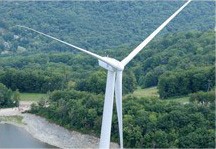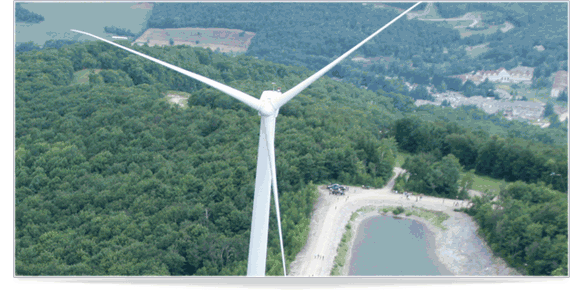|
| JIMINY PEAK CASE STUDY, HANCOCK, MA - Wind Project |  Jiminy Peak uses significant energy for snowmaking, lifts, slope lighting and heat. Rising energy costs are a concern, as passing those costs onto our guests by raising lift ticket prices, could materially jeopardize the health of our industry into the future.
Management had become increasingly aware of fossil fuel’s negative impacts on our environment and potential limited supply causing steep price increases. By August of 2005 Jiminy management was becoming acutely aware of dramatic increases in energy cost on multiple fronts. For the season ending 2004 Jiminy had spent $782,766 on energy, for the 2005 season the amount was $948,421. In just 4 months oil prices had gone up 50% by mid-summer and predications for winter electricity rates indicated there would be a 50% increase. The combined impact of these energy costs were predicated to total $1,451,000. This was prior to the impacts of hurricane Katrina. (Energy costs will exceed 1.5 million dollars for 2005-2006.) In order to help mitigate these potential concerns, Jiminy investigated the potential for a wind turbine site at the mountain.
It was determined that there was an effective turbine location at an elevation of 2,000 feet on the westerly side of the mountain, 350 feet below the summit that also decreased the visual effect on the horizon. There were no impediments from the wind for more than 70 miles to the west, extending to Utica, New York. The site chosen was on the Southwest corner of Jiminy’s 10 million gallon summit reservoir and 1,000 feet away from ski trails.
Jiminy Peak/SED proceeded in obtaining clearance in the following areas:
1. Wetlands study for the access road and site.
2. Wetlands assessment for surrounding area.
3. Avian Assessment, (bird study).
4. A determination by Massachusetts Environmental Protection Agency (MEPA) for an Environmental Notification Form (ENF).
5. Study of rare and endangered species was completed.
6. A letter of opinion was obtained from the National Heritage Society.
7. Civil engineering analysis of site and access roads.
8. Visual Impact Assessment of the project (photo simulations).
On January 3, 2006 Jiminy Peak was in contact with senior management at General Electric Energy and found them willing to assist in the purchase of a wind turbine for late summer of 2006. However, General Electric’s smallest turbine is 1.5 mw, which is taller than the 1 mw turbine initially proposed.
1 mw turbine would be a 224 foot tower structure with 88 feet blades for a total height of 312 feet. The GE 1.5mw turbine structure is 253 feet tall with 123 foot blades for a total height of 386 feet.
The GE turbine technology is proven to be a necessity in order to capture all the positive impacts of the wind. GE’s patented adjusting blade technology enables it to catch every breath of air in order to maximize generation output. GE’s sited several critical issues that needed to be answered in order to proceed further with a purchase.
- A re-evaluation of the wind study and determination of how many kilowatt hours could be generated by a GE turbine indicated it will produce 4.6 MILLION KILOWATT HOURS of electricity. (Jiminy uses 7 million kilowatt hours).
- Turbulence data was necessary in order to assure there would be no excessive vibrations to the turbine over the useful life of the next 50 years. Historical weather information proved there are no turbulence concerns.
- The ability for the turbines connection into Jiminy’s electrical distribution and National Grid’s distribution system was satisfactory answered.
- Civil Engineering and contractor capabilities for hauling this heavier piece of equipment up the mountain and installing it was resolved.
Part of the process was to determine the economic benefit of internal consumption versus power going into the grid. Jiminy was paying 12 cents per kilowatt hour for the supply side of power and would therefore get a 12 cent economic benefit for each kilowatt hour consumed internally. Based on the distribution improvements installed, 2.3 of the 4.6 million kilowatt hours would be consumed internally. The economic benefits for the power going into the grid, off campus, was 5.5 cents plus a 1.9 cents tax credit for a total of 7.4 cents. Obviously, Jiminy’s maximum benefit depended on internal consumption rather than the 4.5 cent reduction for power going into the grid.
The turbine began production in August 2007.
The total cost for the project was 3.9 million dollars.
The return on investment is predicated to take 8 years to payback.
Jiminy’s management is dedicated to this effort with the belief that sustainable type energy will add significant value to the resort in the future.
Representative Dan Bosley applauded Jiminy’s efforts by stating, "It’s great to see a local company thinking globally and acting locally."
Brian Fairbank states, "I am proud of the decision to install a turbine and believe that my great grandchildren will look favorably upon this decision to do something positive and sustainable for the environment long into the future."
  |
|
|





